Abstract
We report on new characteristic features of the plasma-based gravito-electrostatic sheath (GES) model for solar plasma equilibrium characterization through nonthermal (\(\kappa\)-distributed) electrons composed of both a thermal halo (low-speed) and a suprathermal (high-speed) energy tail. The constituent ions are treated collectively as inertial species. The presence of intrinsic fluid turbulence is included with the help of a proper logatropic equation of state in the ionic momentum conservation law. The analysis is based on the basic physics of space-charge polarization effects, collectively evolving as a plasma sheath, but previously known only for laboratory plasma-scales. We show that the radial location of the solar surface boundary (SSB, inner boundary, diffused), formed by the counteracting GES force balancing, becomes slightly enhanced (by 0.5 on the Jeans scale). The net electric current densities, in both the solar interior and exterior, confirm the universal law of total charge conservation in the presence of geometrical curvature effects. The relevant properties of the new \(\kappa\)-modified equilibrium GES structure are numerically illustrated and discussed. The results are finally compared in the light of existing reports based on the Maxwell–Boltzmann electron distribution. The new outcomes can be extensively expanded to analyze the realistic thermostatistical dynamics of the Sun and its ambient atmosphere, as predicted earlier from various space-based observations.



Similar content being viewed by others
References
Adams, F.C., Fatuzzo, M., Watkins, R.: 1994, Astrophys. J. 426, 629.
Bahcall, J.N., Ulrich, R.K.: 1988, Rev. Mod. Phys. 60, 297.
Baluku, T.K., Hellberg, M.A.: 2008, Phys. Plasmas 15, 123705. DOI .
Baluku, T.K., Hellberg, M.A., Kourakis, I., Saini, N.S.: 2010, Phys. Plasmas 17, 053702. DOI .
Cadez, V.M., Jovanovic, G.: 2008, Publ. Astron. Obs. Belgrade 84, 495.
Chamberlain, J.W.: 1960, Astrophys. J. 131, 47.
Cranmer, S.R.: 2002, Space Sci. Rev. 101, 229.
Dorelli, J.C., Scudder, J.D.: 2003, J. Geophys. Res. 108, 1294. DOI .
Dwivedi, C.B., Karmakar, P.K., Tripathy, S.C.: 2007, Astrophys. J. 663, 1340.
Fahr, H.J., Richardson, J.D., Verscharen, D.: 2015, Astron. Astrophys. 579, 18.
Goutam, H.P., Karmakar, P.K.: 2015, Europhys. Lett. 112, 39001. DOI .
Issautier, I., Perche, C., Hoang, S., Lacombe, C., Maksimovic, M., Bougeret, J.L., Salem, C.: 2005, Adv. Space Res. 35, 2141. DOI .
Jeffrey, N.L.S., Fletcher, L., Labrosse, N.: 2017, Astrophys. J. 836, 35.
Karmakar, P.K., Dwivedi, C.B.: 2011, Int. J. Astron. Astrophys. 1, 210.
Karmakar, P.K., Goutam, H.P., Lal, M., Dwivedi, C.B.: 2016, Mon. Not. Roy. Astron. Soc. 460, 2919. DOI .
Khazanov, G.V., Liemohn, M.W., Moore, T.E.: 1997, J. Geophys. Res. 102, 7509.
Ko, Y.K., Fisk, L.A., Gloeckler, G., Geiss, J.: 1996, Geophys. Res. Lett. 23, 2785.
Kiusalaas, J.: 2005, Numerical Methods in Engineering with MATLAB, Cambridge University Press, Cambridge.
Lazar, M., Schlickeiser, R., Poedts, S.: 2012, Suprathermal particle populations in the solar wind and corona. In: Lazar, M. (ed.) Exploring the Solar Wind. Ch. 11, InTech, Rijeka. DOI .
Lemaire, J., Pierrard, V.: 2001, Astrophys. Space Sci. 277, 169.
Livadiotis, G., McComas, D.J.: 2013, Space Sci. Rev. 175, 183.
Loizu, J., Ricci, P., Theiler, C.: 2011, Phys. Rev. E 83, 016406. DOI .
Maksimovic, M., Pierrard, V., Riley, P.: 1997, Geophys. Res. Lett. 24, 1151.
Parker, E.N.: 1958, Astrophys. J. 128, 664.
Pierrard, V., Lazar, M.: 2010, Solar Phys. 267, 153.
Pierrard, V., Lazar, M., Poedts, S., Stverak, S., Maksimovic, M., Travnicek, P.M.: 2016, Solar Phys. 291, 2165.
Priest, E.: 2014, Magnetohydrodynamics of the Sun, Cambridge University Press, Cambridge.
Scudder, J.D.: 1992, Astrophys. J. 398, 319.
Tremblay, B., Vincent, A.: 2017, Solar Phys. 292, 2. DOI .
Vanlommel, P., Cadez, V.M.: 2000, Solar Phys. 196, 227.
Vasyliunas, V.M.: 1968, J. Geophys. Res. 73, 2839.
Zouganelis, I., Maksimovic, M., Meyer-Vernet, N., Lamy, H., Issuatier, K.: 2004, Astrophys. J. 606, 542.
Acknowledgements
We are grateful to the referees for fruitful comments and helpful suggestions. The cooperation from Tezpur University is gratefully acknowledged. We thank the Department of Science and Technology (DST), Government of India, for the financial support through the SERB Fast Track Project (Grant No. SR/FTP/PS-021/2011).
Author information
Authors and Affiliations
Corresponding author
Ethics declarations
Disclosure of Potential Conflicts of Interest
The authors declare that they have no conflicts of interest.
Appendix A: Derivation of the \(\kappa\)-Distribution Law for Electrons
Appendix A: Derivation of the \(\kappa\)-Distribution Law for Electrons
The Lorentzian \(\kappa\)-distributed population density distribution for plasma electrons with all the customary notational symbols [Equation 4 in Baluku and Hellberg 2008] is well known, the expression for which in the customary form is given as
Here, for instant reference in addition to that given in the text, \(n_{\mathrm{e}}\) is the electron population density, \(n_{0}\) the equilibrium plasma population density, \(e\) the electronic charge, \(m_{\mathrm{e}}\) the electron mass, and \(\kappa\) the thermostatistical spectral index. Furthermore, \(V_{\kappa \mathrm{e}}\) is the thermostatistically modified electron thermal speed, given by \(V_{\kappa \mathrm{e}}= [ (\kappa- 3/2)/\kappa ] ^{1/2} v_{\mathrm{th}}\), where \(v_{\mathrm{th}} = (2k_{\mathrm{B}} T_{0}/m_{\mathrm{e}})^{1/2}\) is the usual electron thermal speed. We now introduce the normalized symbols as \(N = n_{\mathrm{e}}/n_{0}\), \(\theta= e\phi /k_{\mathrm{B}} T_{0}\). After simplification, Equation 11 finally reduces to
Equation 12 describes the real thermostatistical behavior of the plasma electrons, as has been explained in the main text, in the Sun and its atmosphere.
Rights and permissions
About this article
Cite this article
Goutam, H.P., Karmakar, P.K. Turbulent Gravito-Electrostatic Sheath (GES) Structure with Kappa-Distributed Electrons for Solar Plasma Characterization. Sol Phys 292, 182 (2017). https://doi.org/10.1007/s11207-017-1192-2
Received:
Accepted:
Published:
DOI: https://doi.org/10.1007/s11207-017-1192-2




